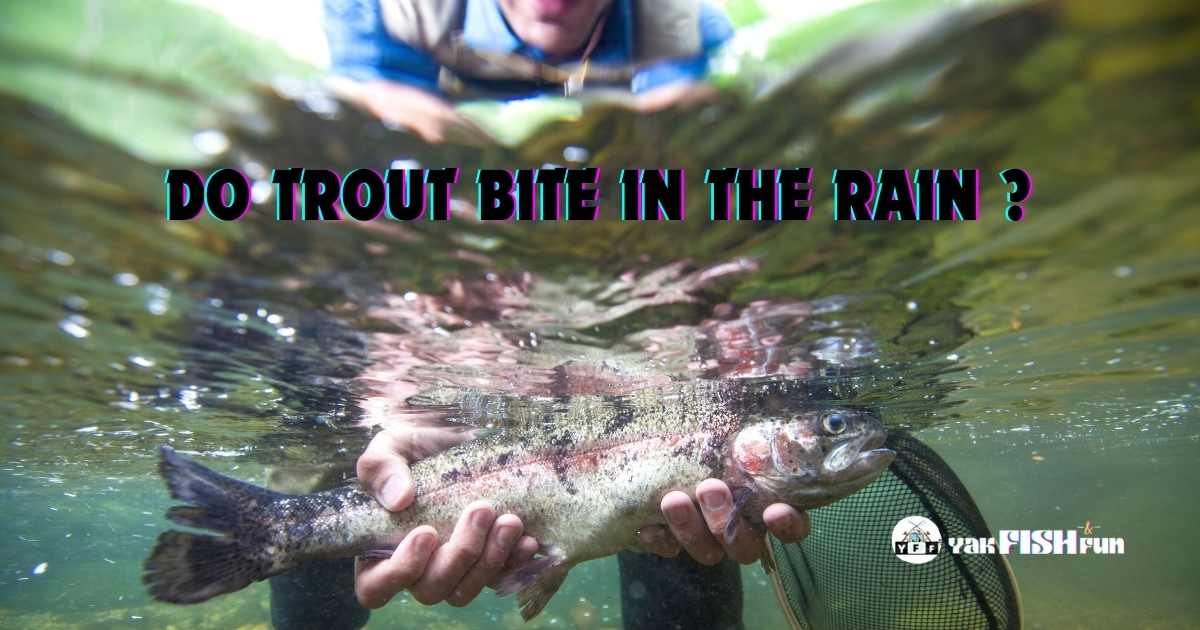Rainy days often keep anglers indoors, but those willing to brave the wet weather might find themselves richly rewarded. The question arises: do trout bite in the rain?
Yes, trout do bite in the rain. Rain can make trout more active and easier to catch.
Rain can indeed stimulate trout activity, making them more likely to bite. The rain stirs up the water, dislodging insects and other food sources, which attracts trout. Overcast skies associated with rain also reduce light penetration, making trout feel safer and more willing to feed.
Anglers can take advantage of these conditions to improve their chances of a successful catch.
In this post, we will explore how rain influences trout activity, examining the reasons behind increased feeding behavior and the best techniques to use when fishing in the rain.
Table of Contents

Understanding Trout Behavior In The Rain – How Trout React To Rainy Conditions
Trout often becomes more active during rain, making it an excellent time for anglers to fish. Rain can increase oxygen levels and wash insects into the water, enticing trout to bite.
Rainy weather often sparks curiosity about how it affects trout behavior. Anglers frequently wonder if these conditions can change their fishing success. Let’s explore how trout react to rainy conditions, giving insights into their behavior.
Increased Activity Levels
During rain, trout tend to become more active. This heightened activity occurs due to several factors:
- Oxygen levels: Rain increases oxygen in the water, invigorating trout.
- Insect activity: Rain causes more insects to fall into the water, providing food.
- Water temperature: Cooler rainwater can make trout more comfortable and eager to move.
Changes In Feeding Patterns
Rain influences trout feeding patterns, often making them more aggressive feeders. Key changes include:
- Visibility: Raindrops disturb the surface, making it harder for trout to see predators.
- Food availability: Washed-in insects and debris offer more feeding opportunities.
- Cover: Increased water flow provides more hiding spots, allowing trout to feed more confidently.
Movement And Migration
Rain can trigger trout to move to different areas. Understanding these movements can improve your chances of catching them:
- River currents: Faster currents push trout towards calmer waters.
- Temperature shifts: Rain can create temperature changes, prompting trout to seek optimal conditions.
- Spawning behavior: In some cases, rain may signal trout to start their spawning migration.
Adaptation To Water Clarity
Rain impacts water clarity, influencing trout’s behavior. Understanding these behavioral changes can significantly enhance your fishing strategy during rainy conditions.
Here’s how they adapt:
- Murky water: Trout rely more on their lateral line system to detect vibrations.
- Reduced light: Low visibility can make trout bolder and more active during daylight.
- Predatory habits: Murkier water enables trout to ambush prey more effectively.
Examining The Different Types Of Trout During Rain
Trout often bite more actively during the rain due to increased food availability. Rain stirs up insects, making trout eager to feed. Different trout species may respond uniquely, creating exciting fishing opportunities.
Rainy days often spark curiosity among anglers: do trout bite in the rain? Understanding the different types of trout can provide valuable insights into their behavior during wet weather.
Rainbow Trout
Rainbow trout are popular among anglers due to their vibrant colors and active nature.
- Habitat: Found in freshwater streams, rivers, and lakes.
- Feeding habits: Known for their aggressive feeding behavior.
- Rain impact: Tend to be more active and bite more during rain.
Brown Trout
Brown trout, though more elusive, offers a thrilling fishing experience.
- Habitat: Prefer cooler, deeper waters in rivers and lakes.
- Feeding habits: Less aggressive, often feeding during low-light conditions.
- Rain impact: May bite more during overcast or rainy days due to reduced light.
Brook Trout
Brook trout, with their stunning markings, are native to North America.
Brook trout thrive in cold, clean, and well-oxygenated waters. They are often found in small streams and mountain creeks. These trout are known for their beautiful colors and distinctive markings.
- Habitat: Prefer cold, clear streams and ponds.
- Feeding habits: Often feed on insects and small fish.
- Rain impact: Increased oxygen levels in rain can make them more active.
Cutthroat Trout
Cutthroat trout are named for the distinctive red or orange streaks on their throats.
Cutthroat trout are known for their distinctive throat slashes and inhabit a variety of water bodies. Their striking appearance makes them a favorite among anglers.
- Habitat: Found in various environments, from high mountain streams to coastal rivers.
- Feeding habits: Opportunistic feeders, eating insects, crustaceans, and smaller fish.
- Rain impact: More likely to bite during rain when insects are more prevalent.
Each type of trout displays unique behaviors and preferences, especially in rainy conditions. Understanding these differences can help anglers make the most of their rainy-day fishing adventures.
The Impact Of Rain On Trout Feeding Habits
Rain can enhance trout feeding activity, as it stirs up insects and increases oxygen levels. Anglers often find trout more willing to bite during a downpour. Rain also reduces visibility, making trout less cautious and easier to catch.
Rain can create a fascinating environment for trout anglers. Understanding how it affects trout feeding habits can help improve your fishing experience.
Changes In Water Temperature
Rain can alter water temperatures, impacting trout behavior. Here are some key points on this effect:
- Cooler water: Rain can lower water temperatures, making trout more active.
- Oxygen levels: Cooler water holds more oxygen, which can increase trout feeding.
- Surface activity: Trout may rise to feed on insects brought down by the rain.
Increased Insect Activity
Rainfall often brings more insects to the water surface. This can influence trout feeding patterns. Consider these aspects:
- Washed-in insects: Rain can wash insects into streams, providing more food.
- Emergent insects: Wet conditions can trigger insect hatches, a prime feeding opportunity.
- Surface disturbance: Raindrops create ripples, disorienting insects and making them easy prey.
Changes In Water Clarity
Rain can change the clarity of water, which affects trout visibility. This has several implications:
- Muddy water: Rain can stir up sediment, reducing water clarity.
- Camouflage: Trout use murky water to hide from predators and anglers.
- Feeding advantage: Reduced visibility can make trout more aggressive feeders.
Increased Water Flow
Rain can lead to higher water flow, which has various effects on trout behavior. Here are some important points:
- Faster currents: High water flow can push trout into calmer areas.
- Dislodged food: Increased flow can wash more food into the water.
- New feeding spots: Trout may move to new areas where food is more accessible.
Impact On Trout’s Senses
Rain can affect trout’s senses, particularly their ability to see and hear. This can change their feeding habits in several ways:
- Noise distraction: Raindrops on the water surface can mask other sounds.
- Reduced vision: Murky water from rain limits trout’s sight range.
- Enhanced smell: Trout may rely more on their sense of smell to locate food.
How To Catch Trout When It Rains
Trout often bite more during the rain due to increased food availability. Raindrops disturb the water, making trout less cautious. Fishing near inlets and using natural bait can improve your chances.
Rainy days can be a trout angler’s secret weapon. The rain changes the environment and trout behavior, often making them more likely to bite. But how can you make the most of these opportunities? Here are some tips to help you catch trout when it rains.
Gear Up For Rainy Conditions
Having the right gear is crucial for a successful rainy-day fishing trip. Here’s what you need:
- Waterproof clothing: Keeps you dry and comfortable.
- Non-slip boots: Ensures safety on wet and slippery surfaces.
- Rain cover for tackle box: Protects your gear from getting soaked.
- Polarized sunglasses: Enhances visibility in low-light conditions.
Choose The Right Bait
Trout can be picky, especially in the rain. Selecting the right bait increases your chances of a bite.
- Live bait: Worms and minnows work well as they mimic natural prey.
- Artificial lures: Bright colors stand out in murky waters.
- Scented baits: Strong scents attract trout in the rain.
Find The Best Spots
Locating trout during rainy conditions is key. Here are some tips on where to fish:
- Near inlets and outlets: Trout gather where water flows in and out.
- Under overhanging trees: These spots provide shelter and food.
- Deeper pools: Trout move to deeper waters during heavy rain.
Adjust Your Technique
Rain affects trout behavior, so adjusting your fishing technique is essential.
- Slow down your retrieve: Mimics the natural movement of prey.
- Use a sinker: Helps your bait reach deeper waters.
- Cast upstream: Allows the bait to drift naturally with the current.
Pay Attention To Water Clarity
The rain can muddy the water, impacting trout’s ability to see your bait. Here’s how to adapt:
- Bright-colored lures: More visible in murky water.
- Larger bait: Easier for trout to spot in low visibility.
- Use scents: Enhances the attractiveness of your bait.
Monitor Weather Changes
The weather can change rapidly during rain. Keep an eye on the conditions to optimize your fishing experience.
- Check weather forecasts: Plan your trip around favorable conditions.
- Watch for lightning: Safety should always come first.
- Observe water levels: Rising water can bring in more trout.
Stay Safe And Comfortable
Fishing in the rain can be rewarding but challenging. Prioritize your safety and comfort.
- Stay warm: Wear layers to keep warm in wet conditions.
- Keep gear organized: Easy access to tools and tackle.
- Hydrate and snack: Maintain energy during your fishing trip.
By using these strategies, you can turn a rainy day into a successful trout fishing adventure.
How To Tell If A Trout Is Biting In The Rain
Trout often bite more actively in the rain due to increased insect activity. Watch for subtle tugs on your line. Pay attention to surface disturbances and splashes, indicating a trout’s presence.
Rainy days can be some of the most productive times for trout fishing. The overcast skies and increased oxygen levels in the water create ideal conditions for trout. But, how can you tell if a trout is biting in the rain?
Let’s explore some key indicators.
Changes In Line Tension
Understanding the changes in your fishing line can help you detect bites.
- Sudden slack: A trout may swim towards you, creating slack in the line.
- Sharp pulls: Quick, strong pulls can indicate a bite.
- Subtle vibrations: Light tremors in the line can signal a cautious trout nibbling.
Watching The Rod Tip
Your rod tip can provide visual cues.
Keep an eye on your rod tip for movement:
- Quick jerks: A rapid movement often means a trout has taken the bait.
- Steady bending: Continuous bending suggests a fish is hooked.
- Tiny twitches: Small twitches might indicate a tentative bite.
Using A Strike Indicator
A strike indicator can enhance bite detection.
Strike indicators are useful, especially in rain:
- Floats or bobbers: These devices move or sink when a trout bites.
- Colored yarn: Bright yarn changes position with any line movement.
- Bead indicators: Small beads slide along the line, showing subtle bites.
Listening For Splashes
The sound of a splash can be a giveaway.
Rain can mask sounds, but pay attention to:
- Loud splashes: Trout breaking the surface to feed.
- Subtle ripples: Small disturbances may indicate feeding activity.
- Continuous splashing: Multiple splashes suggest a feeding frenzy.
Monitoring Water Movement
Water movement can offer clues.
Observe the water surface for:
- Ripples: Persistent ripples might signal active trout.
- Bubbles: Rising bubbles can point to feeding trout.
- Disturbed water: Swirling water often means fish are nearby.
Feeling Through The Reel
Your reel can provide tactile feedback.
Use your reel to sense bites:
- Jerky movements: Feel for sudden, jerky motions.
- Steady pulls: A steady pull indicates a hooked fish.
- Intermittent tugs: On-and-off tugs suggest a tentative trout.
By tuning into these signs, you can improve your chances of detecting trout bites in the rain.
Common Locations For Trout During Rainy Conditions
Trout often bite more during rainy conditions, especially in areas with increased water flow. Look for them near riverbanks, under overhanging trees, and in deeper pools. These spots provide shelter and abundant food, making them ideal for trout during rain.
Rain can actually enhance your trout fishing experience. Trout tends to become more active during rainy conditions, often because the rain stirs up food sources. Knowing where to find them is crucial for a successful fishing trip.
Under Overhanging Trees
Overhanging trees offer trout a sense of security and a steady food supply.
- Protection from predators: The cover of branches and leaves helps trout avoid predators.
- Insects falling: Rain knocks insects from trees, providing an easy meal.
Near Inflows And Outflows
Trout often gather where water flows into or out of a lake or stream.
Rain increases water movement, attracting trout to these spots. The influx of oxygen-rich water is appealing to them.
Deep Pools
Deep pools are popular spots for trout during rain.
- Temperature stability: Deep water maintains a more consistent temperature.
- Food accumulation: Debris and food particles settle in these areas.
Along Banks And Edges
Trout tend to move towards the banks and edges of water bodies.
- Washed-in food: Rain washes insects and other food from the banks into the water.
- Shelter: The edges provide places for trout to hide and feel secure.
Under Bridges And Docks
Structures like bridges and docks can be trout hotspots during rain.
- Shade and cover: These structures offer shade and protection from rain.
- Food sources: They attract insects and other aquatic life.
Understanding these common locations can significantly improve your trout fishing success during rainy conditions. Happy fishing!
Tips For Fishing In The Rain (clothing, Bait, Tackle)
Trout often bite more actively during rain due to increased oxygen levels in the water. Wearing waterproof gear and using bright-colored bait can enhance your fishing success. Ensure your tackle is suitable for wet conditions to avoid any mishaps.
Fishing in the rain can be an exhilarating experience. Trout are more active, and the overcast skies can work to your advantage. But to make the most of your fishing trip, you need to be well-prepared. Here are some tips on clothing, bait, and tackle to help you succeed.
Clothing For Rainy Weather
Dressing appropriately is crucial. Staying dry and comfortable can enhance your fishing experience.
- Waterproof jacket: Keeps you dry and warm.
- Breathable waders: Prevents water from seeping in while allowing sweat to escape.
- Hat with a brim: Shields your face from rain and improves visibility.
- Layered clothing: Ensures you stay warm but can adjust as needed.
Bait Selection In The Rain
Choosing the right bait can make a big difference. Rain affects trout behavior, and your bait should match these changes.
Trout often goes for more visible and lively bait during rain. Live bait like worms can be particularly effective. Artificial lures with bright colors also work well, as they are easier for trout to spot in murky water.
Tackle Adjustments For Rainy Conditions
Tackle adjustments are essential when fishing in the rain. Here are some key points to consider:
- Lighter line: Casts more easily in the rain and reduces drag.
- Barbless hooks: Easier to set and remove, reducing harm to the fish.
- Heavier sinkers: Keeps your bait stable in strong currents.
- Float indicators: Helps you detect subtle bites in turbulent water.
Do Fish Bite Better Or Worse In The Rain?
Fish tend to bite better in the rain. Rain can increase oxygen levels and wash insects into the water, attracting fish.
What Time Do Trout Bite The Best?
Trout bite best early morning or late evening. These times offer cooler water temperatures and lower light levels.
Bottom Line
Fishing for trout in the rain can be very rewarding. Rainy weather creates good conditions for trout, like more oxygen in the water, more insects, and less light, making trout feel safer and more likely to feed. By understanding these factors and adjusting your techniques, you can have successful and memorable fishing trips in the rain. So, next time it rains, don’t let it stop you—grab your gear, go to your favorite fishing spot, and enjoy the unique opportunities that rainy weather brings.


